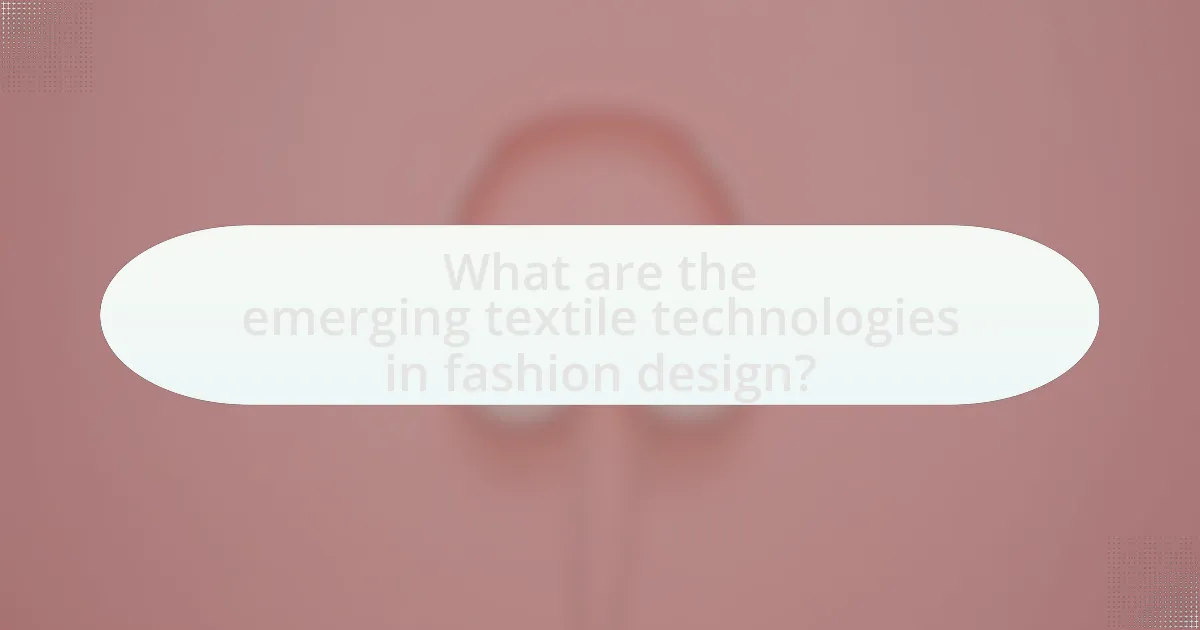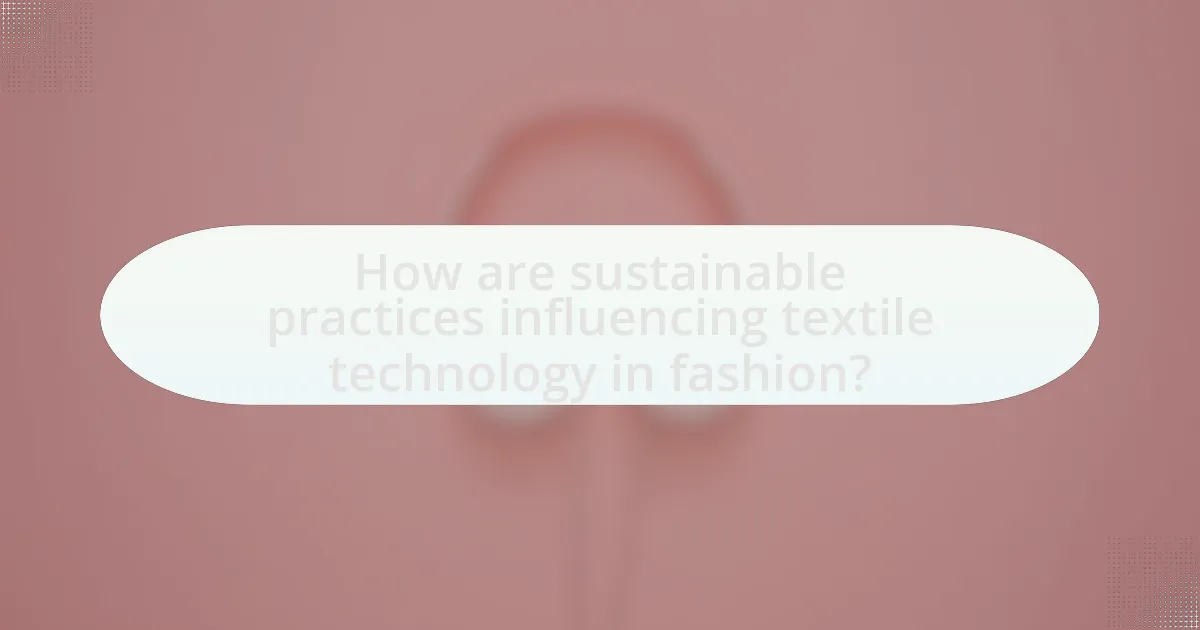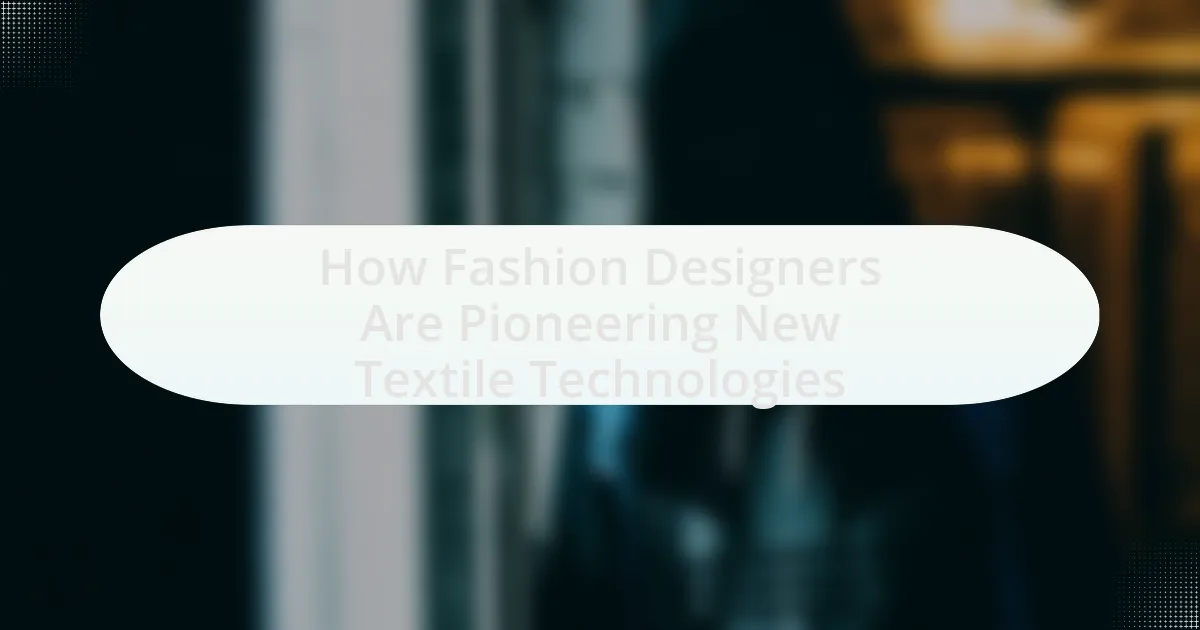The article focuses on how fashion designers are pioneering new textile technologies, highlighting innovations such as 3D knitting, smart textiles, and biofabrication. It explores the integration of advanced materials and digital printing in fashion design, emphasizing the importance of sustainability and functionality in textiles. The piece also addresses the challenges designers face in adopting these technologies, the influence of consumer demand on textile innovation, and the role of sustainable practices in shaping the future of the fashion industry. Additionally, it discusses the impact of these advancements on consumer behavior and offers practical steps for designers to stay ahead in textile technology.

What are the emerging textile technologies in fashion design?
Emerging textile technologies in fashion design include 3D knitting, smart textiles, and biofabrication. 3D knitting allows for the creation of complex garment structures with minimal waste, enhancing sustainability in production. Smart textiles incorporate sensors and conductive materials, enabling garments to respond to environmental stimuli, such as temperature or moisture, which can improve functionality and user experience. Biofabrication involves using living organisms to produce textiles, such as mycelium-based materials, which offer biodegradable alternatives to conventional fabrics. These technologies are reshaping the fashion industry by promoting sustainability, innovation, and enhanced functionality in clothing.
How are fashion designers integrating technology into textiles?
Fashion designers are integrating technology into textiles by utilizing advanced materials, digital printing, and smart textiles. Advanced materials such as bio-fabricated textiles and sustainable fibers are being developed to reduce environmental impact while enhancing performance. Digital printing technology allows for intricate designs and patterns to be applied directly onto fabrics, enabling customization and reducing waste. Additionally, smart textiles incorporate sensors and electronics, enabling functionalities like temperature regulation and health monitoring. For instance, companies like Wearable X have created garments that can track movement and provide feedback, showcasing the practical application of technology in fashion.
What types of technologies are being utilized in textile production?
Various technologies are utilized in textile production, including digital printing, automated weaving, and 3D knitting. Digital printing allows for intricate designs to be applied directly onto fabrics, enhancing customization and reducing waste. Automated weaving technologies improve efficiency and precision in fabric creation, while 3D knitting enables the production of complex shapes and structures without seams, minimizing material usage. These advancements reflect a shift towards more sustainable and innovative practices in the textile industry.
How do these technologies enhance the functionality of fabrics?
Technologies enhance the functionality of fabrics by integrating features such as moisture-wicking, temperature regulation, and stain resistance. For instance, moisture-wicking fabrics draw sweat away from the body, keeping the wearer dry and comfortable, which is particularly beneficial in athletic wear. Temperature-regulating technologies, like phase change materials, adapt to body heat, providing warmth or cooling as needed, thus improving comfort in varying climates. Additionally, advancements in nanotechnology enable fabrics to repel water and stains, increasing durability and ease of care. These enhancements not only improve user experience but also expand the applications of textiles in various industries, including sports, fashion, and healthcare.
Why is innovation in textile technology important for fashion designers?
Innovation in textile technology is crucial for fashion designers because it enables the creation of more sustainable, functional, and aesthetically appealing garments. Advanced textile technologies, such as smart fabrics and eco-friendly materials, allow designers to push the boundaries of creativity while addressing environmental concerns. For instance, the development of biodegradable textiles reduces waste in the fashion industry, which is responsible for significant pollution. Additionally, innovations like moisture-wicking and temperature-regulating fabrics enhance the performance and comfort of clothing, meeting the evolving demands of consumers. These advancements not only improve the overall quality of fashion products but also help designers differentiate their brands in a competitive market.
What challenges do designers face in adopting new textile technologies?
Designers face several challenges in adopting new textile technologies, including high costs, lack of knowledge, and limited access to resources. High costs associated with innovative materials and production processes can deter designers from integrating new technologies into their work. Additionally, many designers may lack the technical expertise required to effectively utilize these advanced materials, which can lead to underutilization or improper application. Limited access to suppliers and manufacturers who can provide these new textiles further complicates the adoption process, as designers may struggle to find reliable partners for production. These challenges collectively hinder the widespread implementation of new textile technologies in the fashion industry.
How does consumer demand influence textile innovation?
Consumer demand significantly influences textile innovation by driving the development of sustainable and functional materials. As consumers increasingly prioritize eco-friendly products, textile manufacturers respond by investing in research and development of biodegradable fabrics and recycled materials. For instance, the global sustainable textile market is projected to reach $8.25 billion by 2027, reflecting a growing consumer preference for environmentally responsible options. Additionally, demand for performance-enhancing textiles, such as moisture-wicking and temperature-regulating fabrics, has led to innovations in smart textiles, integrating technology into fabric design. This shift illustrates how consumer preferences directly shape the direction of textile innovation, compelling brands to adapt and innovate to meet market expectations.

How are sustainable practices influencing textile technology in fashion?
Sustainable practices are significantly influencing textile technology in fashion by driving the development of eco-friendly materials and innovative production processes. Designers are increasingly adopting organic fibers, recycled materials, and biodegradable textiles, which reduce environmental impact. For instance, the use of recycled polyester, derived from plastic bottles, has surged, with brands like Patagonia reporting that over 60% of their products now incorporate recycled materials. Additionally, advancements in dyeing technologies, such as waterless dyeing methods, are being implemented to minimize water usage and chemical waste. These practices not only enhance sustainability but also meet consumer demand for environmentally responsible fashion, as evidenced by a 2021 McKinsey report indicating that 67% of consumers consider sustainability when making a purchase.
What role do fashion designers play in promoting sustainability through textiles?
Fashion designers play a crucial role in promoting sustainability through textiles by innovating eco-friendly materials and advocating for responsible production practices. They influence the fashion industry by selecting sustainable fabrics, such as organic cotton, recycled polyester, and biodegradable materials, which reduce environmental impact. For instance, the Global Fashion Agenda reported that the fashion industry is responsible for 10% of global carbon emissions, highlighting the need for sustainable practices. Designers also raise awareness about the importance of ethical sourcing and waste reduction, often collaborating with textile manufacturers to develop sustainable technologies. By prioritizing sustainability in their collections, designers not only set trends but also encourage consumers to make environmentally conscious choices, ultimately driving the industry towards a more sustainable future.
How are eco-friendly materials being developed and used?
Eco-friendly materials are being developed and used through innovative processes that prioritize sustainability and reduce environmental impact. Fashion designers are increasingly utilizing organic fibers, recycled materials, and biodegradable substances to create textiles. For instance, the use of organic cotton and hemp reduces reliance on synthetic pesticides and fertilizers, while recycled polyester, derived from plastic bottles, minimizes waste and energy consumption. Additionally, advancements in technology, such as 3D printing and biofabrication, allow for the creation of materials that are both sustainable and customizable. Research indicates that the global market for sustainable textiles is projected to reach $8.25 billion by 2027, highlighting the growing demand for eco-friendly options in the fashion industry.
What impact does sustainable textile technology have on the environment?
Sustainable textile technology significantly reduces environmental impact by minimizing waste, lowering water usage, and decreasing carbon emissions. For instance, the use of organic materials and recycling processes in sustainable textiles can cut water consumption by up to 90% compared to conventional methods. Additionally, innovations such as biodegradable fabrics and closed-loop production systems help divert textile waste from landfills, contributing to a circular economy. Research indicates that adopting sustainable practices in the textile industry can reduce greenhouse gas emissions by approximately 30%, highlighting the positive environmental effects of these technologies.
Why is it crucial for fashion designers to prioritize sustainability?
It is crucial for fashion designers to prioritize sustainability because the fashion industry is one of the largest contributors to environmental degradation, accounting for approximately 10% of global carbon emissions. By adopting sustainable practices, designers can significantly reduce waste, lower carbon footprints, and promote ethical labor practices. For instance, the use of eco-friendly materials and innovative recycling techniques can minimize resource consumption and pollution. Furthermore, a 2021 report by the Ellen MacArthur Foundation highlights that transitioning to a circular economy in fashion could yield $560 billion in economic benefits while reducing environmental impact. Thus, prioritizing sustainability is essential for both ecological preservation and economic viability in the fashion sector.
How can sustainable textile technologies improve brand reputation?
Sustainable textile technologies can significantly improve brand reputation by demonstrating a commitment to environmental responsibility and ethical practices. Brands that adopt these technologies often attract environmentally conscious consumers, leading to increased customer loyalty and positive brand perception. For instance, a 2021 survey by McKinsey found that 67% of consumers consider sustainability when making purchasing decisions, indicating that brands utilizing sustainable textiles can enhance their market appeal. Additionally, companies like Patagonia have successfully built strong reputations by prioritizing sustainable practices, showcasing that transparency and innovation in textile technology can lead to a competitive advantage in the fashion industry.

What are the future trends in textile technology for fashion design?
Future trends in textile technology for fashion design include the development of sustainable materials, smart textiles, and 3D printing. Sustainable materials, such as bio-fabricated textiles and recycled fibers, are gaining traction as designers seek to reduce environmental impact. Smart textiles, which incorporate sensors and electronics, enable garments to interact with the wearer and the environment, enhancing functionality and user experience. Additionally, 3D printing technology allows for rapid prototyping and customization, enabling designers to create intricate patterns and structures that were previously impossible. These trends are supported by industry reports indicating a growing demand for eco-friendly and innovative solutions in fashion, reflecting a shift towards more responsible and technologically advanced design practices.
How are advancements in technology shaping the future of textiles?
Advancements in technology are significantly shaping the future of textiles by enabling the development of smart fabrics and sustainable materials. Smart textiles, which incorporate sensors and electronics, allow for functionalities such as temperature regulation and health monitoring, enhancing user experience and utility. For instance, companies like Wearable X have created fabrics that can track movement and provide feedback, demonstrating the integration of technology into everyday clothing. Additionally, innovations in sustainable textile production, such as biofabrication and recycling technologies, are reducing environmental impact. Research from the Ellen MacArthur Foundation indicates that the fashion industry could reduce its carbon footprint by 44% by 2030 through the adoption of circular economy practices, showcasing the potential for technology to drive sustainability in textiles.
What innovations are expected to emerge in the next decade?
Innovations expected to emerge in the next decade include advanced sustainable textiles, smart fabrics, and 3D printing technologies in fashion. Sustainable textiles will likely incorporate bio-based materials and recycling processes, reducing environmental impact. Smart fabrics, embedded with sensors and connectivity, will enhance functionality, allowing for real-time data collection and interaction. Additionally, 3D printing will enable on-demand production, minimizing waste and allowing for customization. These trends are supported by the increasing consumer demand for sustainability and personalization in fashion, as evidenced by a 2021 McKinsey report highlighting a significant shift towards eco-friendly practices in the industry.
How will these trends affect consumer behavior in fashion?
Trends in textile technology will significantly influence consumer behavior in fashion by increasing demand for sustainable and innovative materials. As consumers become more environmentally conscious, they are likely to prefer brands that utilize eco-friendly textiles, such as organic cotton or recycled materials. A report by McKinsey & Company indicates that 67% of consumers consider sustainability when making a purchase, highlighting a shift towards brands that prioritize ethical practices. Additionally, advancements in smart textiles, which offer functionalities like temperature regulation and moisture-wicking, will attract tech-savvy consumers seeking enhanced performance in their clothing. This shift towards innovative and sustainable options will reshape purchasing decisions, leading to a more informed and conscientious consumer base in the fashion industry.
What practical steps can designers take to stay ahead in textile technology?
Designers can stay ahead in textile technology by actively engaging in continuous education and collaboration with textile engineers and technologists. This involves attending industry conferences, workshops, and seminars focused on the latest advancements in materials and production techniques. For instance, the Textile Society of America hosts events that showcase innovative textile research and applications, providing designers with insights into emerging technologies. Additionally, designers should invest in research and development to experiment with sustainable materials and smart textiles, as the global market for smart textiles is projected to reach $5.3 billion by 2024, according to a report by MarketsandMarkets. By integrating these practices, designers can remain at the forefront of textile innovation.
How can designers effectively collaborate with tech companies for innovation?
Designers can effectively collaborate with tech companies for innovation by establishing interdisciplinary teams that integrate design thinking with technological expertise. This collaboration fosters a shared understanding of user needs and technological capabilities, leading to innovative solutions. For instance, the partnership between fashion designers and tech firms like Google has resulted in advancements such as smart textiles that enhance functionality while maintaining aesthetic appeal. Such collaborations leverage the strengths of both fields, enabling the development of cutting-edge products that meet market demands.

Leave a Reply